London Overground: Four stops to explore the 'real' London
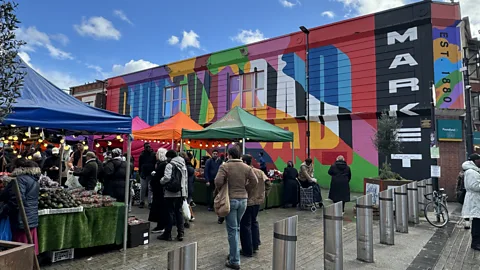 Robyn Wilson
Robyn WilsonLondon's revamped Tube map not only shines a light on the city's diversity and history but will show visitors a new side to London beyond zones 1 and 2.
It's one of the most recognisable maps in the world and arguably the most talked about: the London Tube. Hated by some, adored by others, the collection of colour-coded straight lines, intersecting at 45-degree angles, dispenses with geographical accuracy to such an extent that you could easily station-hop for half an hour to a destination that was in fact a five-minute walk down the road.
This perhaps explains why more than 90 years after it was designed by Henry ("Harry") Beck, the map remains a topic of fierce debate today – particularly when changes are involved. The latest controversy came this February when it was revealed that the London Overground – the city's suburban rail network – which appears on the Tube map as a sprawling orange network, would be divided into six lines, each with its own colour and name . They include the Windrush and Suffragette Lines, with some of the names criticised for being "woke" or "virtue signalling" due to their focus on women and minority groups.
Others feel the map is getting too cramped. "It would have been nice if they'd renamed the Overground and combined it with a wonderful new map," said Dr Maxwell Roberts, a transit map designer and psychologist. "The problem is they've been squeezing stuff onto this map since 2000 and it's failing to do what Beck managed to, which is to turn London into simple straight lines."
Away from the debate, however, London's revamped Overground will make it easier for visitors to experience the capital beyond its well-trodden sights in zones 1 & 2. And that's a good thing: it's in these lesser-known parts of London where you'll find some of its most vibrant communities and fascinating history. Here are four places travellers should go to see the "real" London.
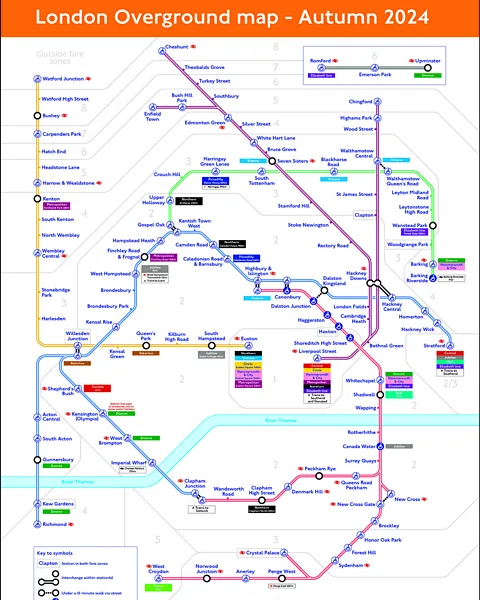 TfL
TfL1. Explore a thriving Caribbean community on the Windrush Line
The Windrush Line runs through areas with strong ties to Caribbean communities, such as Dalston Junction, Peckham Rye and West Croydon, and honours the generation of Commonwealth citizens who, arriving on the HMT Empire Windrush ship, came to live in Britain between 1948-1971. They are known as the Windrush generation.
Hackney in East London was one of the places where many people from the Windrush generation settled and it remains a vital social hub to connect with and learn about Caribbean culture.
Here, Caribbean culture is visible from every street corner, from local street art and roti shops to specialist bakeries, hairdressers and local Caribbean greengrocers.
A two-minute walk from Hackney's Dalston Junction station down Gillet Street will get you to Ewart's Jerk, one of many Caribbean restaurants in the area. Here, you'll likely find locals chatting outside to a background of reggae music and big BBQ barrels releasing seductive plumes of smoke every time owner Ewart checks his jerk chicken and pork belly.
Not far away on Balls Pond Road, is Peppers and Spice, a legendary Caribbean takeaway renowned for their flaky pastry patties filled with classics like spiced callaloo greens, salt fish and pepper or ground beef.
At the heart of all this sits Dalston's Ridley Road Market, famously known as one of the settings for the hit Netflix show Top Boy, a defining drama about inner-city London life and immigration. Beyond that, however, this more-than-140-year-old market has long been a place with a rich black heritage.
That first generation of Caribbean businesses around Ridley Road began selling ingredients not readily available at the time, and the stalls still brim with produce such as yam, plantain and ackee, while specialist butchers sell chicken feet and pig snout, which can both be added to dishes like souse, a classic Caribbean broth flavoured with scotch bonnets, garlic, onion, spices and lime.
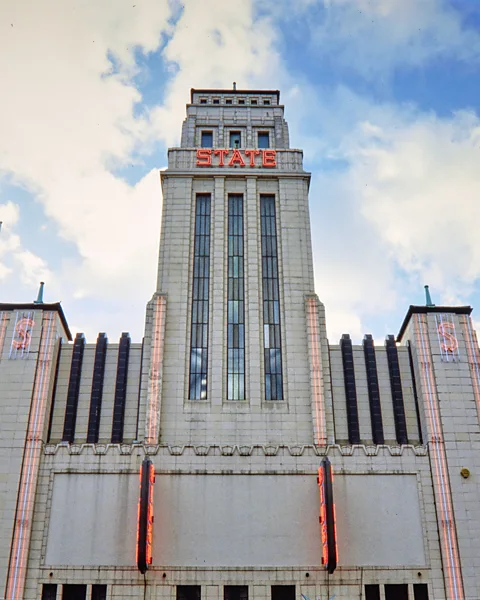 Getty Images
Getty Images2. See lesser-known musical landmarks via the Lioness Line
While The Lioness Line, which runs from Euston to Watford Junction, is so named for the lasting legacy created by the England women's football team, the route is also home to some musical landmarks that are definitely worth a visit.
From Kilburn High Road station, it's just a 15-minute walk from Abbey Road Studios, most famous for the time the Beatles spent there between 1962-1970. But before you make a dash for photos across the famous Abbey Road zebra crossing, head down Kilburn High Road to see the Kilburn State puncturing the clouds.
This Art Deco, Grade II-listed building (now occupied by Ruach City Church) was originally built as a cinema in 1937, a few years after the Empire State Building, with its facade paying tribute to the New York landmark. Its seating capacity of 4,004 made it the largest in England at the time and it quickly became a legendary music venue, hosting an endless stream of artists like Django Reinhardt, Frank Sinatra, Buddy Holly, the Rolling Stones and, of course, the Beatles. Today, visitors can still ire the building from outside.
Across the road from Kilburn State is the Kilburn National Club, another former cinema-turned-music venue that hosted names like Johnny Cash, David Bowie and Nirvana. Today, it is occupied by the Evangelical church group UCKG HelpCentre, but its impressive domed Grade-II listed building can be ired from the street.
A 13-minute walk towards West Hampstead, meanwhile, will get you to the building once occupied by Decca Studios, the label that turned down the Beatles after they auditioned there in 1962. Head there to see a plaque that has been installed on the building's exterior – an ideal last stop before heading to Abbey Road.
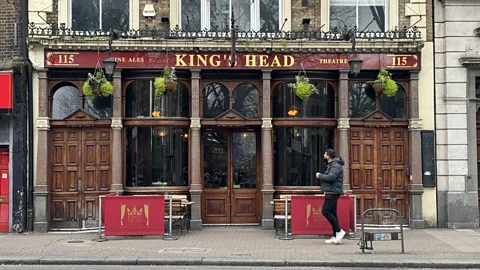 Robyn Wilson
Robyn Wilsonvia the Mildmay and Windrush Lines
The Mildmay Line, which runs from Stratford to Richmond/Clapham Junction, honours a small charitable hospital in Shoreditch that played a pivotal role in caring for people during the HIV/AIDS crisis in the 1980s and made the area a valued place for London's LGBTQ+ community.
To learn more, take the Overground to Highbury & Islington station, where there's a wealth of LGBTQ+ history to explore – much of which is unknown even to most local residents.
That's why Islington Heritage, a local council department, launched the Islington Pride initiative in 2017, an interactive digital and physical archive that allows visitors to create and follow tailored-made walking tours to key LGBTQ+ landmarks and points of interest. Many have received physical pink plaques to mark the routes as well as QR codes to link you to their backstory.
Head over to Highbury Fields, for example, a leafy green park about five minutes from Highbury & Islington station, and you can visit the spot where, on 27 November 1970, 150 of the Gay Liberation Front staged their first demonstration.
"That was a precursor to the UK's Pride festivals," said Seán McGovern, the heritage project manager who headed up the programme
Islington has a number of other LGBTQ+ firsts, too. It was home to the UK's first feminist bookshop Sisterwrite, which became a hub for feminist and lesbian communities (although no longer a bookshop, the building still stands on 190 Upper Street). Chris Smith, MP for Islington South and Finsbury, became the UK's first MP to publicly come out as gay in 1984. The area is also home to the UK's oldest LGBTQ+ charity, London Friend, which is still running today.
In addition to the heritage walks, travellers should visit London's first pub theatre, King's Head Theatre, which focuses specifically on LGBTQ+ work, writers and themes. Central Station is also one of the last remaining LGBTQ+ bars in Islington, while the ivy-covered Hemingford Arms pub embraces its LGBTQ+ history with a pink plaque. Nightclub Egg London, meanwhile, hosts dedicated queer nights.
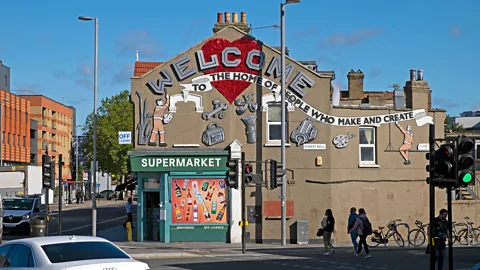 Alamy
Alamy4. Soak up the East London's creative vibe via the Suffragette Line
While the Suffragette Line is named to celebrate how London's East End working-class community fought for women's rights, the route also takes you into another chapter of London's history: one of industry and innovation.
Jump off at Walthamstow's Blackhorse Road station and visit the ever-expanding Blackhorse Beer Mile, an industrial estate within the borough that's being transformed by an influx of exciting craft drinks producers.
A look back at the borough's history and you'll discover it manufactured the first British car, the Bremer, in the 1892, and is home to the unique Walthamstow Pump Museum that pays tribute to its transport and industrial heritage, including holding supper club dining experiences in an old Victoria Line underground tube.
More like this:
- How six colours update the iconic London Tube map
- See another side to London at eight of its most unusual tourist attractions
Today, that theme of innovation continues, breathing fresh life into its industrial spaces. This has been driven in part by cheaper rents, which have enabled start-up businesses priced out of central London locations to set up a thriving creative community.
The independent craft brewing scene had been steadily growing here before the beer mile officially launched in 2022, but business is now flourishing. Signature Brew, Exale and Big Penny Social were some of the first names to , with entrepreneurs expanding beyond just beer in recent months to include an urban winery.
The newest recruit is Burnt Faith, the UK's first dedicated brandy house, which, in addition to having a bar (with a dedicated brandy cocktail list), runs distillery tours and tastings.
"It's not only just breweries and drinks producers, of which there are now quite a few, but generally the vibe here is just incredibly creative," said Burnt Faith founder, Simon Wright. "You've got Blackhorse Lane Ateliers [a craft jean maker] just behind us and Slow Burn [a vegetarian-focused restaurant], so you've got all these creative industries going on."
Before heading over for a drink, start with a walk around the Walthamstow's protected wetlands, which is conveniently located next to the beer mile. On a good day you can see all sorts of wildlife across the 211-hectare Thames Water reservoir site, including rare waterfowl and birds of prey. And rest assured, if you get tired, the London Overground is never far away.
---
